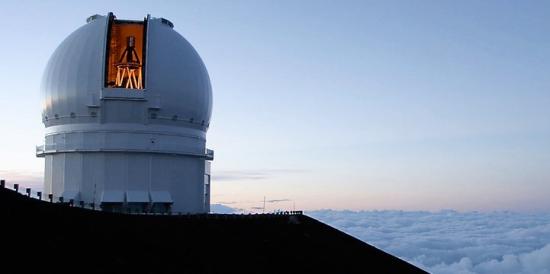2013 October: unveiling new habitable worlds and exploring their birth with SPIRou
The Canada France Hawaii Telescope (CFHT) confirmed its participation to the funding of SPIRou
How do stars and planets arise ? How does the magnetic field affect their formation? Is the Earth, whose surface is covered by a large amount of liquid water, unique? Is our galaxy populated by similar planets? These are a few universal questions of particular concern to researchers in stellar and planetary astrophysics to which SPIRou should provide new answers in the next decade.

SPIRou is not only a spectropolarimeter [1] which decomposes the light of the stars into its different colors and its basic vibration modes, but also a high precision velocimeter [2]. Like a road radar which would flash the observed star, not because of its too high speed, but because of the regular and periodic variations of its speed, SPIRou will be able to detect the tiny movements of a star indicating the presence of an orbiting planet. SPIRou will thus go on search for Earth like planets in the planetary systems of red dwarf stars located close to the Sun. The atmospheres of these twin planets will eventually be scanned with the James Webb Space Telescope [3], the future space telescope, in search for water and other bio-molecules associated with the life presence. SPIRou will also be able to unravel the mysteries of the birth of stars and planets, observing for the first time the magnetic fields of protostars as young as a few hundred thousand years.
On a technological level, SPIRou is also a major challenge. It must operate in the infrared in order to observe at best the cold stars known as red dwarfs. This requires immersing the heart of the instrument, the spectrometer, into a cryostat cooled to the temperature of liquid nitrogen (-200 °C) to prevent the ambient heat radiation, ubiquitous in the infrared, from eclipsing the tiny starlight that you want to decrypt. In addition, to enable the detection of the nanoscale movements of the spectra that will reveal the presence of habitable Earths, the thermal stability of the cryostat must be exceptional as to ensure a constant temperature with an accuracy of a few thousandths of a degree Celsius.
Identified as a priority project of the Centre National de la Recherche Scientifique (CNRS), SPIRou is one of the key elements that should ensure the future of the telescope over the next decade. The CFHT [4] has just confirmed its financial participation in SPIRou.
SPIRou is an international project led by France – involving IRAP (CNRS / Université Toulouse III – Paul Sabatier), IPAG (CNRS / Université Joseph Fourier), LAM (CNRS / Aix-Marseille Université), IAP (CNRS/UPMC) as well as eight laboratories in Région Ile de France, and the associated Observatories. Besides France and the CFHT, the SPIRou consortium [5] also implies Canada, Brazil, Taiwan, Switzerland and Portugal. The construction of SPIRou should begin in 2014, the integration in Toulouse (at the IRAP) is scheduled for 2016 and a first light at CFHT is planned for 2017.
Further details :
The budget for this international project reflects its major scientific challenge ; it amounts to € 10 million (construction cost of € 4 million included). The French consortium, which gathers several universities, observatories and laboratories under the dual supervision of the CNRS and the Ministère de l’Enseignement Supérieur et de l’Education (MESR), especially based in Toulouse, Grenoble, Marseille and Ile de France, largely contributes to the financement and the realization of the project.
The integration of the instrument is scheduled for 2016 in Toulouse, at the University of Toulouse III – Paul Sabatier, within the Midi-Pyrénées Observatory (OMP), at the Institute for Research in Astrophysics and Planetology (IRAP) and a first light is planned at the CFHT in 2017.
Spirou has also found an ally for the dissemination of its future discoveries among the young audiences, creating a partnership with the Journal de Spirou !

Notes :
- Spectropolarimeter: instrument able to perform, not only the spectrum of a starlight, but also the analysis of its (linear or circular) polarization – resulting for example from the Zeeman effect of a magnetic field upon the formation of the spectral rays.
- Radial velocity method: method which aims to detect, by Doppler effect, the speed variations which a planet communicates to the star around which it orbits. For an habitable exoEarth around a red dwarf, the radial velocity variations are of the order of one meter per second, and their measurement requires a high resolution spectrograph of extreme stability, called a velocimeter.
- JWST: The James Webb Space Telescope (JWST) will succeed the Hubble Space Telescope (HST) in 2018. It is a mission led by the NASA in which Europe, under the responsibility of the European Space Agency (ESA), and Canada, through the Canadian Space Agency (CSA), take part. The telescope will have a collecting area seven times greater than the HST and will be devoted to the observation of the universe in the infrared spectrum (from 1 to 27 micron wavelength).
- CFHT: Sentinel of heaven atop the Mauna Kea – a 4200 meters volcano located on the Big Island of Hawaii – the CFHT is a 3.6 meters telescope operating several instruments. Although based atop one of the best astronomical sites in the world, the CFHT is not immune to competition and must constantly innovate through an ambitious science policy, in order to keep a prominent place in a world of giant telescopes. The CFHT is an organization jointly owned by the National Research Council of Canada, the Centre National de la Recherche Scientifique in France via the National Institute of the Sciences of the Universe (INSU-CNRS) and the University of Hawaii. More information: http://www.cfht.hawaii.edu/fr/apropos/
- The universities, research institutes, laboratories and financial partners involved in SPIRou are :
- at the national level : the Centre National de la Recherche Scientifique (CNRS) and the Ministry of Higher Education and Research (MESR)
- at Toulouse, the University Toulouse III – Paul Sabatier, the Observatoire Midi-Pyrénées (OMP), the Institut de Recherche en Astrophysique et Planétologie (IRAP), the Region Midi-Pyrenees.
- at Grenoble, the Université Joseph Fourier (UJF), the Observatoire des Sciences de l’Univers de Grenoble (OSUG), the Institut de Planétologie et d’Astrophysique de Grenoble (IPAG)
- in Ile de France, the Institut d’Astrophysique de Paris (IAP), the Observatoire de Paris (OP), the Laboratoire d’Etudes Spatiales et d’Instrumentation en Astrophysique (LESIA), the Laboratoire d’Etudes du Rayonnement et de la Matière en Astrophysique (LERMA), the Laboratoire Univers et Théories (LUTH), the Institut de Mécanique Céleste et de Calcul des Ephémérides (IMCCE), the Service d’Astrophysique (SAp) / Laboratoire AIM du Commissariat à l’Energie Atomique (CEA), the Institut d’Astrophysique Spatiale (IAS) and the Laboratoire Atmosphères, Milieux, Observations Spatiales (LATMOS), the Région Ile de France.
- at Marseille, the Laboratoire d’Astrophysique de Marseille (LAM) and the Observatoire de Haute-Provence (OHP), two parts of the Observatoire des Sciences de l’Univers Institut Pythéas, an observatory of the CNRS and of the Université d’Aix-Marseille.
- internationally: at Hawaii, the Canada-France Hawaii Telescope (CFHT) ; in Canada, the University of Montreal (UdeM) in Montreal, the Laval University (UL) in Quebec and the National Research Center (NRC) in Victoria ; in Switzerland, the Geneva Observatory (OG) in Geneva ; in Brazil, the National Laboratory for Astrophysics (LNA) at Itajuba, the Federal University of Rio Grande do Norte (UFRN) at Natal, and the Federal University Minas Gerais (UFMG) at Belo Horizonte ; in Taiwan, the Institute of Astronomy and Astrophysics, the Academia Sinica (asiaA) in Taipei ; in Portugal, the Center for Astrophysics at the University of Porto (CAUP ) at Porto.
- at the national level : the Centre National de la Recherche Scientifique (CNRS) and the Ministry of Higher Education and Research (MESR)
Contacts :
Researcher : Jean-Francois Donati, Tel : 05 61 33 29 17, jean-francois.donati@irap.omp.eu
Project Manager : Driss Kouach, Tel : 05 61 33 28 73, driss.kouach@obs-mip.fr


